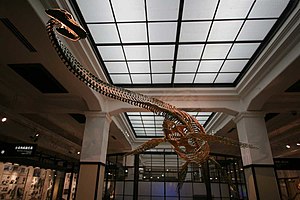Futabasaurus
| Futabasaurus | ||||||||||||
|---|---|---|---|---|---|---|---|---|---|---|---|---|

Reconstruction of the skeleton of Futabasaurus suzukii |
||||||||||||
| Temporal occurrence | ||||||||||||
| Upper Cretaceous ( Santonium ) | ||||||||||||
| 85.8 to 83.5 million years | ||||||||||||
| Locations | ||||||||||||
|
||||||||||||
| Systematics | ||||||||||||
|
||||||||||||
| Scientific name | ||||||||||||
| Futabasaurus | ||||||||||||
| Satō , Hasegawa & Manabe , 2006 | ||||||||||||
| species | ||||||||||||
|
Futabasaurus is a genus of plesiosaurs from the late Cretaceous period of Fukushima in Japan . The approximately seven meters long and three to four tons heavy animal inhabited the coastal waters of the Cretaceous period off Japan and belonged to the family of the Elasmosaurids . The genus and type species F. suzukii were only described in 2006, 38 years after the discovery of the fossils . It is the first finding of an elasmosaurid in the northern Pacific . The find is ondisplayin the National Museum of Natural Sciences in Tokyo .
discovery
The fossil remains of Futabasaurus suzukii were found in 1968 in the Inoceramus amakusensis zone of the Irimazawa member of the Tamayama formation in the Futaba group in the Japanese prefecture of Fukushima by the then high school student Suzuki Tadashi. It was the first fossil record of a larger reptile on Japanese soil. It was not until 2006 that Futabasaurus suzukii was described as a new species with its own genus due to various characteristics. The type species Futabasaurus suzukii differs from other elasmosaurs and the like. a. by a greater distance between the eyes and the nostril, a longer shin and the shape of the connection between the collarbone and the interclavicle .
A number of shark teeth were discovered between the fossil bones of the specimen found in Fukushima. This can be attributed either to predation or to scavenging by the sharks.
Naming
The generic name Futabasaurus is derived from the location in the Futaba group, while the specific epithet refers to the surname of the discoverer, Suzuki Tadashi. Immediately after the discovery of the fossil, it was proposed to name it Wellessaurus suzukii after Samuel Welles , who first investigated the finds , but at the time it could not be determined whether it was a new species. It was not until 38 years after the discovery in May 2006 that a three-person Japanese research team was able to determine that it was a new species of a new genus and proposed the name Futabasaurus suzukii in accordance with the applicable nomenclature rules .
The long time span of 38 years between the find and the first description can be explained by the worldwide lack of material necessary for the comparison of different species and genus-typical characteristics. Against the background of increased finds of elasmosaurids since the nineties, they were finally classified into a new genus. However, it is unclear whether the specimen was a female or a male animal.
In 1990 the Futaba group found the fossil remains of a theropod , for which the scientific name Futabasaurus was also proposed. However, since there is no first description necessary for the scientific name, this is a noun nudum without validity as a scientific name according to the International Rules for Zoological Nomenclature . The generic name Futabasaurus was therefore still available until the work of Satō, Hasegawa and Manabe.
Individual evidence
- ↑ a b Tamaki Sato, Yoshikazu Hasegawa, Makoto Manabe: A new elasmosaurid plesiosaur from the upper cretaceous of Fukushima, Japan. In: Palaeontology. Vol. 49, No. 3, 2006, ISSN 0031-0239 , pp. 467-484, doi : 10.1111 / j.1475-4983.2006.00554.x .
- ↑ shinkan.kahaku.go.jp ( page no longer available , search in web archives ) Info: The link was automatically marked as defective. Please check the link according to the instructions and then remove this notice. - National Museum of Natural Sciences
